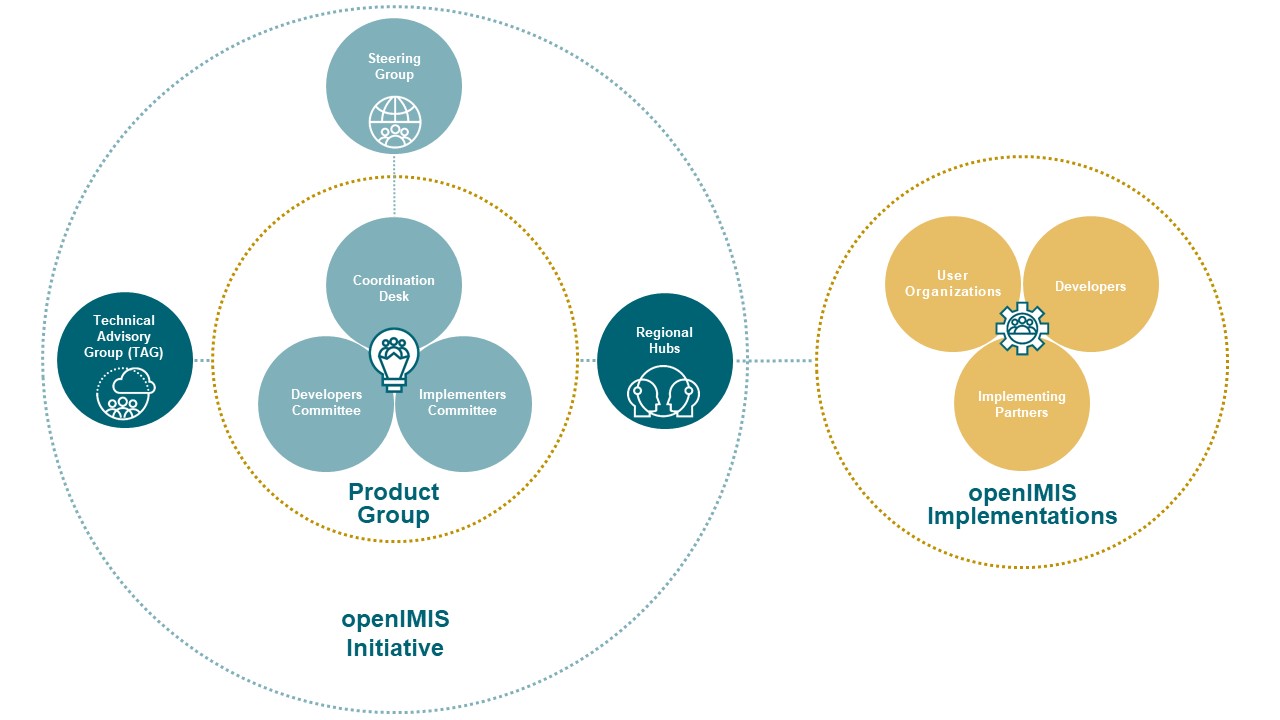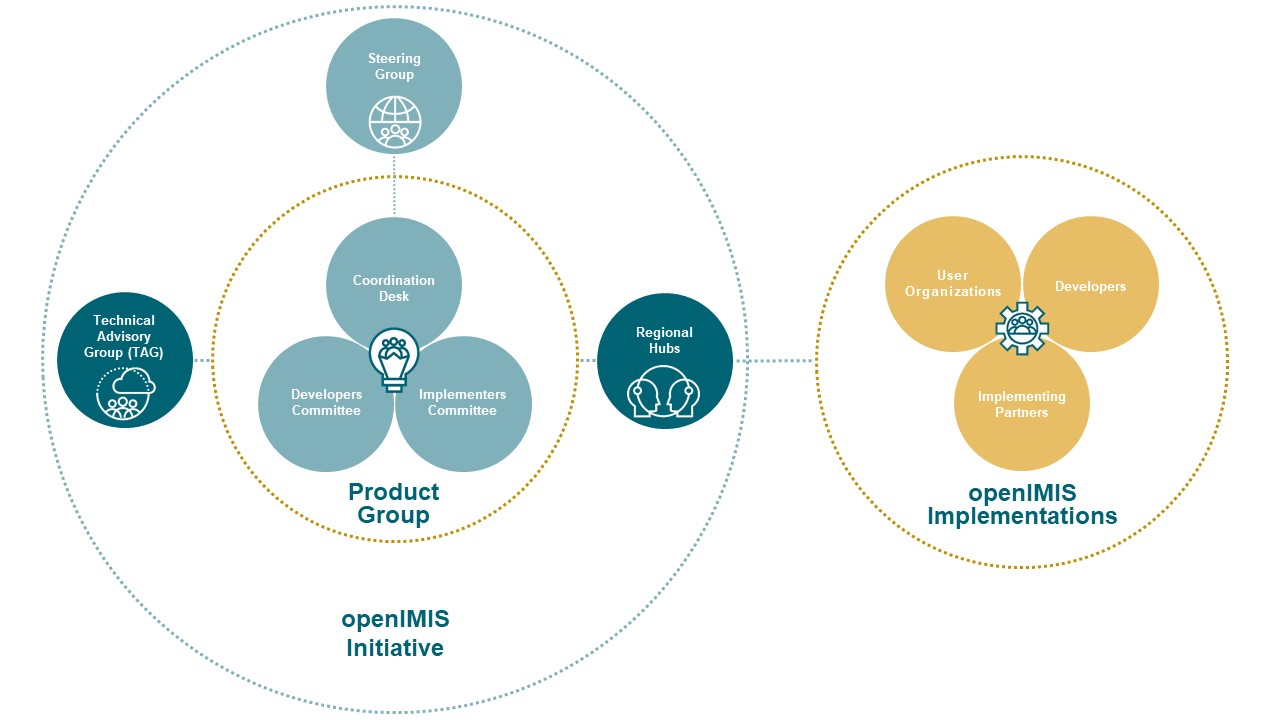Subcategories:
| Child pages (Children Display) | ||||
|---|---|---|---|---|
|
...
| Table of Contents |
|---|
Background and
...
Objectives of openIMIS and its
...
Governance Structure
The openIMIS initiative is focused on creating a sustainable community of practice of various types of users and contributors to the openIMIS software product. In order to achieve and sustain this vibrant openIMIS community, a governance structure to facilitate the various processes within the initiative has been designed. The governance structure aims to define roles and responsibilities to various actors within the community in order to create an efficient and transparent system of information flow and knowledge dissemination. The governance structure aims to bring various stakeholders - current and potential users, implementation and software development experts, specific subject experts onto common platforms to learn about openIMIS, to help develop openIMIS further, or to help spread information about openIMIS further.
The aim of the global openIMIS Initiative is to create a software centred community, where different individuals and organisations at diverse levels are able to contribute to the development and implementation of the openIMIS product. The main objectives of this organisational structure are to:
Create transparent and efficient governance structures which assign clear roles and responsibilities to the different actors (user countries with their (health) insurers implementing openIMIS, implementation partners, relevant health financing actors, software developers, centralized technical support organisation, technical advisory group, steering group, program coordination desk)
Offer opportunities for individuals and organisations to learn about openIMIS and become a service provider, e.g. as implementation partner or local support team
Create an ecosystem which offers
insurancesocial protection?organisations a range of qualified implementation,
training and software development/ integration partners to choose from
Create a stable structure to ensure proper maintenance of existing MS IMIS and to create a user support structure for existing MS IMIS user organisations
Create a structure for the continuous improvement through addition of new modules and step-by-step transition to a modular open source solution
Develop a business model where the organisations that use openIMIS contribute to a stable financing of the openIMIS core operations.CIF - funding
Role of the 'initiative' for capacity development?
capacity development tools availability
capacity development geared at general awareness building on openIMIS capabilities/functionality etc
'on-board' business process (health financing, social protection etc) and ICT experts on openIMIS
interoperability with other tools in the area - policy side
'Grow' openIMIS to be beyond health insurance/financing
insurance organization → scheme operator
legacy - modular : transition
present openimis as a 'solution' to a problem rather than just a 'tool' or software
security
performance
data privacy/ethics
financing of openimis implementations/country level
evidence based communication about openIMIS
growth of the community - local
openIMIS initiative - facilitating the discussion, provides a forum, brings experts to talk about business processes and openIMIS functionality matching; NOT providing the business process solutions.
If direct business process solution design/other scheme design support is required - the initiative recommends service providers.
show that openimis is the best tool on the market to solve the problems of the customer. evidence!
independence of evidence?
encourage 3rd party evaluations ..
...
Roles and responsibilities of parties
A first step towards an organisational structure is the clear definition of roles and responsibilities. For each of the suggested roles we distinguish between ongoing and case driven activities. This distinction serves to separate the more predictable ongoing activities from the case driven activities
...
.
Figure 1: Organisational scheme
The following overview briefly describes the role of each partner:
Steering Groupdefines overall strategic direction
<<excerpt from ToRs>>
CIF - funding
Product Group forms the core group of the openIMIS Initiative.
Create a stable structure to ensure proper maintenance of existing MS IMIS and to create a user support structure for existing MS IMIS user organisations
Create a mechanism for the continuous improvement through addition of new modules and step-by-step transition to a modular open source solution
Support for the transition of implementation from legacy to modular
detailing required - in a separate page.
Role of the 'initiative' for capacity development on:
capacity development geared at general awareness building on openIMIS capabilities/functionality etc
'on-board' business process (health financing, social protection etc) and ICT experts on openIMIS
legacy - modular : transitionmarketing & info-sharing on openIMIS
generate/curate evidence-based knowledge for openIMIS promotion
eg. show that openIMIS is the best tool on the market to solve the problems of the customer. evidence!
independence of evidence?
encourage 3rd party evaluations ..
facilitate exchange between various stakeholders of the openIMIS initiative - eg. Toumai, IC
Architectural team?
It consists of:
Coordination Deskoperationalizes defined strategic direction, administrates budgets and oversees the activities of the involved working groups.Developers Committee develops, maintains and supports at global level the core of openIMIS
Implementers Committeesupports at global level implementations regarding implementation steps, training material, requirements of business processes for openIMIS.
Technical Advisory Group(TAG) assesses the openIMIS Initiative evaluating strategic developments, proposes on system architecture and new functional requirements. The members of the TAG will be nominated by the Steering Group.
...
'Grow' openIMIS to be beyond health insurance/financing
insurance organization → scheme operator
interoperability with other tools in the area - policy side
discussion required to detail TAG execution/implementation.
Implementing Partners
Consultantsfacilitates the outreach to the implementations in the countries andprovides support to scheme operators for implementing openIMIS
increasing the uptake of openIMIS in more schemes/countries
builds the link between global and local Community
capacity building for specific implementation
providing business process solutions
experts in the field of the scheme and the use of ICT for its management
Regional hubs provide support to the community on regional level as well as facilitates training and capacity development
present openimis as a 'solution' to a problem rather than just a 'tool' or software
security
performance
data privacy/ethics
evidence based communication about openIMIS
financing of openimis implementations/country level
Local support / Dev. Team provides direct support to the payers and providers
Payers provide feedback on the features of openIMIS and identify future requirements for the system
3 Process flows
In order to clearly define the roles, to avoid overlaps, double work and gaps not covered by any organisation, the main processes of the planned organizational set-up need to be defined in detail, assigning activities to each partner. In this section, a few of the main processes are drafted.
In the column “Who” a main responsible is assigned, sometimes a second organisation is added in brackets to support the process.
3.1 Release Management (Software Maintenance)
One of the main challenges with release management is to coordinate the development of MS IMIS and open source application.
Table 1: Release management workflow
...
Scheme operators,
Implementation Partners
...
- Immediate solving of minor software issues regarding master version (mainly bugs when software does not comply with specifications)
- Compilation of feature requests into user requirements and add it to the backlog and preparation for discussion
...
- Joint review of consolidated user requirements, including interfaces and joint timelines.
- Budget estimation
- Prioritisation of user requirements
- Preparation of feature roadmap for TAG review
...
- Technical specification of the requirements
- Development of new functionality (Development (Specification, design, coding & unit testing, security testing, integration testing, user acceptance testing), Release, update documentation. Update Demo Version)
...
- Release sign off and release management (source code repository and updating supporting documentation, etc.)
- Backwards compatibility needs to be implemented according to TAG guidance.
3.2 User support workflow
The main idea is that there is a centralized ticket system (starting at 3rd tier), where users can submit their issues that cannot be solved at country level.
-
Table 2: User support and issue management workflow
...
In case the issue can be resolved without much effort, it can be closed.
...
3.3 Country sales and implementation workflow
There are several possible constellations, how the sales process can unfold. In general, the proposal process should be based on open competition, spreading implementation know-how to a growing number of international, regional and national implementation partners. The IT & Product Team and GIZ should assume the role of supporting the proposal processes of implementation partners upon request.
-
Table 3: Implementation workflow
...
Initial contacts and general information
- Creation and maintenance of website, general presentation material, participation at events (together with Partners, e.g. to show case country best practise)
- Support with lead generation
- Mitigation in case of overlapping sales interest of different partners
...
Insurance Agency(potential customer) –Program Coordination Desk
...
- Insurer expresses interest in openIMIS. In case the contact is directly with GIZ, GIZ can explore the implementation options. GIZ and partners should agree on a standard procedure for this process.
- In case the contact is through another development partner, coordination with GIZ will be sought and options for sharing of roles in funding and supporting the customer will be explored with SG.
...
- In case of a direct contact between an implementation partner and an Insurer, the implementation partner can lead the sales effort.
- Implementation partners should aim to include in their proposals to the customer a fee to refinance the global openIMIS Initiative.
- Presentations, customer contact
- Proposal (technical support through GIZ where required and possible)
...
Figure 1: Organisational scheme
Further Pages
| Child pages (Children Display) | ||||
|---|---|---|---|---|
|

